Page 112 of 352 pages « First < 110 111 112 113 114 > Last »
Extract
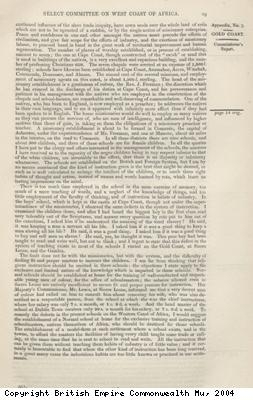
Description:
Extract reporting on Dixcove trading fort,on the West Coast of Africa. Europeans used forts such as Dixcove as bases for trading along the West African coast. These trading forts were used for temporarily housing enslaved Africans until they could be loaded onto waiting ships anchored nearby.
From Report from the Select Committee on the Coast of West Africa; together with the minutes of evidence , 1842.
Date: 1842
Copyright: Copyright British Empire Commonwealth Mu
Instructions

Description:
Instructions regarding the trading forts on the West Coast of Africa and their use after Abolition (when trading in slaves became illegal), 1840. The report mentions the activities of slave traders who were (illegally) still trading. Europeans used forts as bases for trading along the West African coast. These trading forts were used for temporarily housing enslaved Africans until they could be loaded onto waiting ships anchored nearby.
From Report from the Select Committee on the Coast of West Africa; together with the minutes of evidence , 1842.
Date: 1842
Copyright: Copyright British Empire Commonwealth Mu
Extract
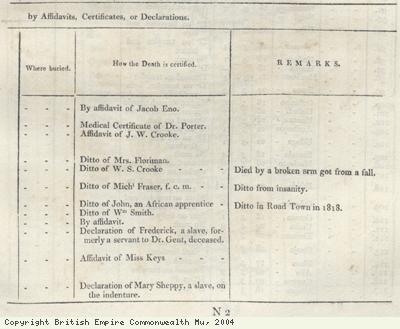
Description:
Extract from a table listing the state and condition of the captured negroes condemned in the Court of Vice Admiralty . This extract gives the figures for males dead, of which proof has been given by Affadavits, Certificates or Declarations . The men were on board captured ships which were illegally trading after the Abolition Act was passed (a new law which meant that the trading in slaves was no longer legal). The ships was condemned in the Court of Vice Admiralty at Tortolla, an island off Nevis in the Caribbean. From, Slave Trade Papers Relating to Captured Negroes , Tortola Schedule, 1825.
The language used to describe people of African descent in the 18th, 19th and 20th centuries is unacceptable in today’s terms. We cannot avoid using this language in its original context. To change the words would impose 20th century attitudes on history.
Date: 1807-23
Copyright: Copyright British Empire Commonwealth Mu
Table
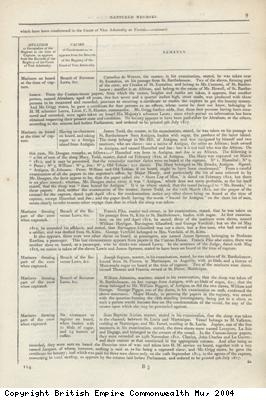
Description:
Table listing African and Creole Negroes , 1807-1823, who were on board ships which were captured for illegally trading after the Abolition Act was passed (a new law which meant the trading in slaves was no longer legal). The ships were condemned in the Court of Vice Admiralty at Tortolla, an island off Nevis in the Caribbean. From, Slave Trade Papers Relating to Captured Negroes , Tortola Schedule, 1825.
The language used to describe people of African descent in the 18th, 19th and 20th centuries is unacceptable in today’s terms. We cannot avoid using this language in its original context. To change the words would impose 20th century attitudes on history.
Date: 1807-1823
Copyright: Copyright British Empire Commonwealth Mu
Table

Description:
Table listing African and Creole Negroes , 1807-1823, who were on board ships which were captured for illegally trading after the Abolition Act was passed (a new law which meant the trading in slaves was no longer legal). The ships were condemned in the Court of Vice Admiralty at Tortolla, an island off Nevis in the Caribbean. From, Slave Trade Papers Relating to Captured Negroes , Tortola Schedule, 1825.
The language used to describe people of African descent in the 18th, 19th and 20th centuries is unacceptable in today’s terms. We cannot avoid using this language in its original context. To change the words would impose 20th century attitudes on history.
Date: 1807-1823
Copyright: Copyright British Empire Commonwealth Mu
Table
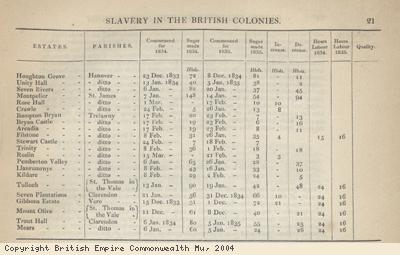
Description:
Table showing the plantations in Jamaica and their sugar returns. The table shows the days when the crops started, and the hours of labour of each crop per day. From Papers Relative to Abolition of Slavery, Part II, 1833-35.
Date: 1833-35
Copyright: Copyright British Empire Commonwealth Mu
Table
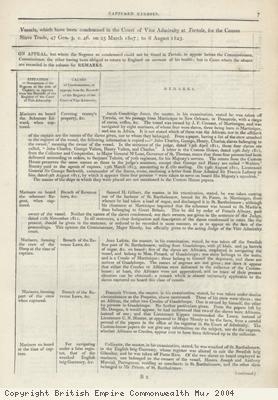
Description:
Table listing African and Creole Negroes , 1807-1823, who were on board ships which were captured for illegally trading after the Abolition Act was passed (a new law which meant the trading in slaves was no longer legal). The ships were condemned in the Court of Vice Admiralty at Tortolla, an island off Nevis in the Caribbean. From, Slave Trade Papers Relating to Captured Negroes , Tortola Schedule, 1825.
The language used to describe people of African descent in the 18th, 19th and 20th centuries is unacceptable in today’s terms. We cannot avoid using this language in its original context. To change the words would impose 20th century attitudes on history.
Date: 1807-1823
Copyright: Copyright British Empire Commonwealth Mu
Table
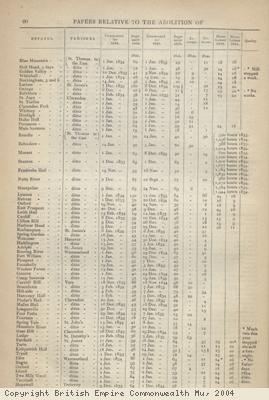
Description:
Table showing the plantations in Jamaica and their sugar returns. The table shows the days when the crops started, and the hours of labour of each crop per day. From Papers Relative to Abolition of Slavery, Part II, 1833-35.
Date: 1833-35
Copyright: Copyright British Empire Commonwealth Mu
Letter
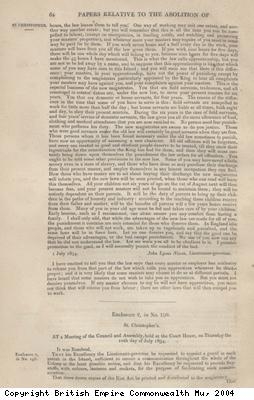
Description:
Letter from Governor General of St Kitts to Secretary of State for the Colonial Department, 10th July,1834. Report that slaves plan to resist the apprenticeship system and planned to strike from 1st August, the date when the new law came into effect. (Slaves who were freed under the Emancipation Act, were then forced to work as apprentices).The Governor General had gone around parishes on the island to explain the new system, but the slaves were not willing to listen. Speech enclosed with letter.From Papers Relative to Abolition of Slavery, Part II, 1833-35.
Date: 10th July 1834
Copyright: Copyright British Empire Commonwealth Mu
Despatch from British government

Description:
Copy of a despatch from British government to Governor of Antigua regarding proposed amendments to Emancipation Act (a law which gave slaves their freedom) and payment of compensation to owners for the loss of their slaves. From Papers Relative to Abolition of Slavery, Part II, 1833-35.
Date: 1833-35
Copyright: Copyright British Empire Commonwealth Mu
Page 112 of 352 pages « First < 110 111 112 113 114 > Last »

